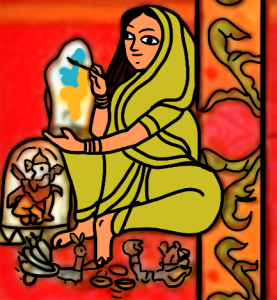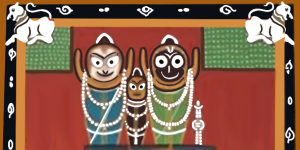The Culture and Civilisation of India are among the most ancient and rich in the world. Art and culture have been an essential and integral part of human civilization. The Indian sub-continent can be divided into three distinct regions. There are study materials available, such as NCERT books, which have chapters such as Art and Culture Class 11: Styles of Painting, which thoroughly outline this topic covering Tanjore Painting, Mithila Painting, or Madhubani painting, Jharnapatachitra, Patachitra of Orissa, etc.
Different regions and their types of paintings
- Rajasthan: Chittorgarh artists create wooden shrines with doorways that could be opened to display intricately painted mythological or devotional stories. Wooden kavads are used in worship and on special occasions
- Maharashtra: Paintings illustrating their lifestyle, such as planting saplings, transporting grain, dancing, and traveling to the market, are displayed on the walls of Warli tribal homes in the Thane district
- Vegetation, mammals, insects, birds, and symbols of the Solar system, Moon, and Stars demonstrate their belief in the unification of all forms of life
- Warli dwelling walls are coated with excrement on ritual and ceremonial occasions
- Rice paste and red ochre powder are used to tell stories and invoke the blessings of Palaghata, the Goddess of Fertility
- Tamil Nadu: Tanjore Painting is an intriguing blend of art and craft which thus arose under Maratha’s dominance in Thanjavur, Tamil Nadu
- Red, Yellow, Black, and White are the primary colors used in Tanjore painting
- Aristocratic or religious people are shown in magnificent architectural arches and entrances, flanked by elaborate architectural arches and doorways
- Tanjore painting is encrusted with semi-precious stones and was initially created on wood
- The artworks were of Tanjore painting were then transferred to glass
- Color is applied to the glass artworks from the outside inward
- Because the artist paints the artwork from the backside of the glass, the outlines and finishing touches must be completed first
- Bihar: Madhubani painting, also known as Mithila painting, was created in the Madhubani District
- To commemorate festivals, women adorn the nuptial chamber and the interior walls of their homes with Madhubani paintings
- ‘Return of Ram from exile’ and ‘Krishna playing with gopis’ are two themes primarily used in Madhubani painting
- Nature, harvest, tantric motifs of snake worship, and even city landscapes are among the sceneries drawn in Mithila painting
- West Bengal: Jharnapatachitra is an incredible religious tale on a sizeable vertical paper scroll
- Artists write melodies that they chant while they unfold each scene of the painting one by one
- To strengthen the scroll, an old cloth is put on the back

Jharnapatachitra of West Bengal
- Orrisa: The Patachitra of Orissa exhibits religious stanzas from ancient poets, singers, and scribes, as well as tales from the classic poem the Geet Govind
- Initially, the picture was created as a temple sacrifice
- Tales are etched as etchings on palm leaf or painted on paper and silk in portions
- These paintings have deep red, ochre, black, and vivid blue colors derived from minerals, shells, and biological lac
- Artists have been motivated to paint on wooden boxes and picture frames due to modern innovations

Patachittra, Orrisa
- Pan-India: On festive seasons, mehndi, aka henna, is applied to the hands and feet to create auspicious signs, patterns, and designs
India today has a rich mixture of different types of painting, each borrowing from the other and evolving a style peculiar to an area or a community. There is a continuous interplay between the forms and influences from far away. The earliest Indian art was largely monumental or architectural, with some examples of painting on the walls of temples dating back to the early Harappan period.
Here are a few styles of paintings that flourished through the ages across the country;
Madhubani painting
Madhubani paintings, also known as Mithila paintings, are mostly created by women and originated in the Madhubani village of Bihar. Many tools, such as fingers, twigs, brushes, nib-pens, matchsticks, and natural colours, are used in this style of Indian painting. These are done on walls, floors of holy places, canvases, and other surfaces. These brightly coloured Madhubani paintings are distinguished by geometrical patterns and are widely practised in Bihar’s Madhubani district. These paintings were originally done on mud walls and soil ground or floors. They are now also created on canvases, cloth, and handmade paper. It is one of India’s most celebrated and popular folk painting styles.
Phad painting
This style of Indian folk painting is popular in the Indian state of Rajasthan. Phad painting is a religious scroll painting style that is traditionally done on a long piece of cloth or canvas called a Phad. Phads depict Rajasthani folk deities, primarily Pabuji and Devnarayan. Bhopas, priest-singers of Rajasthan’s folk deities, carry and perform in front of a Phad, which serves as a portable temple. It is a narrative scroll painting tradition in which stories about their deities and heroes, such as Prithviraj Chauhan, are painted in predominantly red, yellow, and orange colours.
Warli painting
This type of tribal art is associated with one of Maharashtra’s major tribes, the Warlis. It’s been around for over 2500 years. It primarily depicts local people’s daily activities, such as farming, dancing, praying, hunting, sowing, and so on, as well as natural elements.The primary focus of these paintings is to depict social and everyday life. They are more concerned with nature than with mythological characters and deities.
Kalamkari painting
The Kalamkari art form is practised by many families and people in Andhra Pradesh and some villages in Tamil Nadu. It is derived from the words “Kalam” meaning pen and “Kari” meaning craftsmanship. Kalamkari is commonly used to depict scenes from epics such as the Ramayana and Mahabharata, musical instruments, animals, Buddha and Buddhist art, flowers, and Hindu symbols such as swastika.
Gond painting
This is a type of Indian folk and tribal art. They are practised by the Gond community of Madhya Pradesh. The word “Gond” is derived from the Dravidian expression Kond, which means “green mountain.” For over 1400 years, this art form has been practised. They typically depict flora and fauna, people going about their daily lives, deities, festivals, and celebrations. They reenact mythological stories, natural phenomena, significant events, and rituals. These are paintings that are bold, bright, and vibrant, with intricate work and rich detailing.
Patachitra painting
Patachitra, also known as Pattachitra, is a traditional cloth scroll painting art form from Odisha and West Bengal. The art form primarily depicts mythological and religious themes, epics, Hindu deities, and other such subjects. Thia Badhia – a depiction of Lord Jagannath’s temple, Krishna Lila – an enactment of Lord Jagannath as Lord Krishna displays his powers as a child, Dasabatara Patti – Lord Vishnu’s ten incarnations, and Panchamukhi – Lord Ganesh’s depiction as a five-headed deity are some of the popular themes that the Patachitra art form represents.
Tanjore painting
Tanjore as well as Thanjavur painting is an old Hindu folk art form that originally came in Thanjavur, a town in southern India. It is a painting style from South India that dates back to 1600 AD. The use of gold foil, which gives the painting a surreal appearance, the colourful panel painting done on a wood plank with a deity as the main theme, and the use of semi-precious stones and vibrant colours distinguish these paintings.
Cheriya scrolls
The Cheriyal Scroll Painting style is a revised form of Telangana’s Nakashi art. These 40-45 foot scrolls, painted in a narrative style, depict stories from Indian mythology, Puranas, and the Epics. These Cheriyal Scrolls are handwoven khadi fabric.
Kalamezhuthu
Kalamezhuthu is an indian Traditional and ritualised art form that is practised in Kerala temples and holy groves. It is performed as an offering for the blessings of gods and deities such as Kali, Ayyappan, Bhadrakali, serpent god, and others. Natural pigments and powders are used to create the illustrations of these deities on the floor. White – rice flour, black – charcoal powder, yellow – turmeric powder, green – powdered green leaves, and red – a mixture of turmeric powder and lime are the most commonly used coloured powders.
Mandana
Mandana art is decorative, tribal, and one of the oldest Indian art forms. It is painted on the walls and floors of homes in Rajasthan and Madhya Pradesh to protect the home and fireplace. Mandanas are built to welcome gods as well as to celebrate special occasions. The first Mandana artists were Meena women from Rajasthan and Madhya Pradesh.
Rajput Paintings
Rajput paintings, also known as Rajasthani paintings, developed and flourished in the Rajputana royal courts of Rajasthan in the 17th and 18th centuries. The Hindu epics Mahabharata and Ramayana, as well as scenes from Hindu mythology, serve as the primary illustrations. The paintings are filled with minute details and bright colours. Colors are derived from minerals, plants, clams and shells, vegetables, and even precious stones.
Chittara paintings
The women of the Deewaru community in Karnataka’s Sagar district practise this Indian folk art form. Chittara paintings are intricate wall paintings created with natural materials such as rice paste and yellow seeds. The paintings are done on the walls and floors of their village homes, which are made of red mud. These Chittara paintings generally depict tribal people’s daily lives, birds and animals, flowers used for pooja, ceremonies, deities, socioeconomic activities, toys for children, and so on.
Bhil Art
This is another tribal art form practised by the Bhils, India’s second largest tribal community. The Bhils are a superstitious people who live in Madhya Pradesh, Gujarat, Rajasthan, and Maharashtra. They place a high value on art, and the rich textures of their paintings connect their lives to nature. Bhil paintings are traditionally created on the clay walls of their village homes using neem sticks, twigs, and natural colours.
Mysore painting
Mysore painting developed in Karnataka’s Mysore city and uses thin gold leaves, similar to Tanjore paintings. The most common themes in these paintings are Hindu gods, deities, and scenes from Hindu mythology. There are several steps involved in the creation of a Mysore painting. The artist begins by drawing an initial drawing of the picture on the base with cartridge paper collected on a wooden base.
Conclusion:
India has a very rich culture and tradition, which is reflected in its amazing art and craft. Every region and state in India is associated with a specific art form, such as Madhubani painting in Bihar, Pithora painting in Gujarat, Warli painting in Maharashtra, Kalamkari painting in Andhra Pradesh and Telangana, and Gond art in Madhya Pradesh. There are numerous Indian folk art forms that have received international recognition and acclaim. Through these art forms, we express our feelings, emotions, and thoughts, as well as admire our surroundings, nature, flora, and fauna, and respect our deities and mythology.
 Profile
Profile Settings
Settings Refer your friends
Refer your friends Sign out
Sign out













